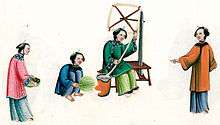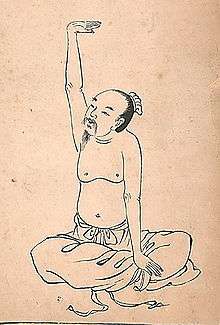Silk reeling
Silk reeling (pinyin chánsī, Wade-Giles ch'an² ssu1 纏絲) refers to a set of neigong (内功, internal) movement principles expressed in traditional styles of t'ai chi ch'uan (太極拳), but especially emphasised by the Chen 陳 and Wu 吳家 styles. The name derives from the twisting and spiralling movements of the silkworm larva as it wraps itself in its cocoon, and to the metaphorical principle of "reeling the silk from a silk worm's cocoon". In order to draw out the silk successfully the action must be smooth and consistent without jerking or changing direction sharply. Too fast, the silk breaks, too slow, it sticks to itself and becomes tangled. Thus silk reeling movements are continuous, cyclic, twisting and untwisting actions. Silk reeling is a core method of movement and is trained throughout the curriculum including solo forms, individual solo exercises (chan si gong), as well as in two-person work (push hands).

As described by Wu Kung-tsao:
This resembles the strands of spun silk. Winding silk energy is applied in pushing hands when opponents probe, use locking maneuvers, neutralize, vie for control, and practice tactical movements around each other's space.There are six methods of winding silk energy: inner, outer, upper, lower, forward and backward. They are applied from anywhere on the body: the arms, legs, hips and waist, with the body moving continuously, with endless circularity, wrapped together like intertwined filaments of silk.
...
One who is skilled at winding silk energy is keenly sensitive and can accurately probe and stay with the opponent as he extends and contracts.[1]
Chán sī jīn (纏絲精) isn't easily translated but refers to the development of a spiral (helical) refined force - rather than brute strength - and the ability to direct that to a point of application. Chán sī gōng (纏絲功), literally, chan si work, refers to performing solo training exercises aimed at learning and improving one's understanding and ability to perform silk reeling.
In Chen style Taijiquan, silk reeling is the method used to coordinate the parts of the body to achieve whole-body movement: when one part moves, all parts move, or, when the dantian moves, the whole body moves. It also is the primary method for circulating "qi" from the centre (dantian) to the extremities and back from the extremities to the centre.
In Chen style Taijiquan, silk reeling has nothing to do with tracing Tai Chi diagrams with hands or feet.
See also
References
- Wu, Kung-tsao (2006) [1980]. Wu Family T'ai Chi Ch'uan (吳家太極拳). Chien-ch’uan T’ai-chi Ch’uan Association. ISBN 0-9780499-0-X.
External links
- Training in Chenstyle Taijiquan at the Wayback Machine (archived December 18, 2007). Chenstyle Taijiquan Web Resource - Chenstyle.com. Archive 2007-12-18.
- Chen "Silk Reeling" (ChanSiGong/ChanSiJing): Chen style Taichi Centre. Double Hand Silk Reeling article & video (by Malisa Ng, disciple Grandmaster Zhu Tian Cai) Retrieved 2009-08-30
- Photo Gallery at the Wayback Machine (archived August 23, 2007). Sydney Tai Chi and Qigong Centre. Pictures - Double Hand Silk Reeling (by Grandmaster Chen Xiaowang). Archive 2007-08-23.
- Silk Reeling. Michael Garofalo. Cloud Hands: Taijiquan and Qigong, March 8, 2008. Various Resources. Retrieved 2009-08-30.
